
IFE RECENT EXCAVATIONS
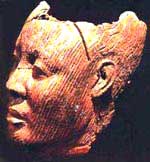 |
| 1 - Lagos,
National museum Terracotta |
At Igbo Obameri, several
fragments of terracotta were excavated by Oliver Myers, who also worked at
Oduduwa College site. Myers observed that his major finds at Igbo Obameri were
near the surface and consisted of fragments of sculptures which he judged were
dug up annually and reburied. He thought, like Fagg at Osangangan Obamakin, that
the sculptures were brought to the shrine in fragments and that the shrine might
have been built in the nineteenth century. However, at Oduduwa College site,
Myers discovered two terracotta heads, one of which is illustrated here (Fig. 1), which he claimed to have found in situ.
The important site of Ita Yemoo was discovered by accident when fine
terracotta and bronze sculptures were encountered during a building operation.
Scientific excavations carried out later at the site by Frank Willett, on behalf
of the Department of Antiquities, put the finds into context. Willett believes
that Ita Yemoo was a shrine, and that unlike on previous occasions when
sculptures were recovered from secondary contexts, here they were found in situ
and had not been brought in at a comparatively recent date.
The finds consisted of:
 |
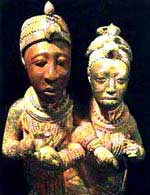 |
|
| 2 - Ife museum. Bronze |
3 - Ife museum. Bronze |
- a complete bronze figure of an Oni (Fig. 2);
- a bronze royal pair with interlocking hands and feet (Fig. 3);
- a small bronze vessel mounted on a stool almost encircled by a queenly looking figure (Fig. 4);
- two bronze staffs with gagged human heads (Fig. 5) and
- terracotta heads, some with elaborate head-dresses or crowns,( for example (Fig. 6).
The next important site, Obalara’s
Land, was excavated by Peter Garlake. It yielded a great quantity of terracotta
sculptures and ritual pots. Some of the sculptures were purposely arranged in
concentrations. Among these were six human torsos, six naturalistic heads, a
conical head with naturalistic features and two conical heads with stylized lips
and mouth.
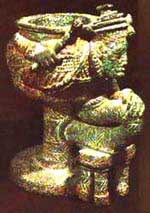 |
| 4 -
Lagos, National museum Bronze bowl |
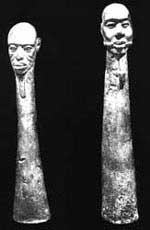 |
| 5 - Ife museum. Bronze |
The ritual pots are comparable to the one which was discovered by the writer at
Koyiwo Layout and illustrated here (Fig. 6).
It incorporates applied reliefs of some cult objects: skulls, shrines, a pair of
tongs, and a pair of Edan (brass) heads associated with the Ogboni cult.
Altogether, five such pots are known; from Obalara’s Land, Koyiwo Layout,
Osangangan Obamakin, and one known only from fargments illustrated in Willett’s
book on Ife. Obalara’s
Land is considered to have consisted of a number of compounds with impluvia and
shrines. The sculptures are claimed to have been found in situ.
Finally, the writer has excavated two sites in Ife, namely, Odo Ogbe Street
site and Lafogido. Odo Ogbe Street site was discovered by accident and its
excavation revealed that a classical terracotta head (Fig.
7) having been found elsewhere, was re-used in a more recent
ritual context.
Lafogido, on the other hand, is regarded as a primary organic site. It is said
that a former Oni of that name was buried there, and there is some evidence to
suggest that the site was a tomb, although most unlikely to be that of Lafogido
who, according to the present Oni, reigned late in the nineteenth century.
Excavation was not completed at the site because the present Oni believes it is
improper to dig up royal remains. However, enough evidence was revealed to shed
light on the use of Ife sculptures.
The excavation disclosed a rectangular pavement with a series of pots set inside
the edges. In some cases, the rims of the pots were flush with the pavement,
while in others the greater parts of the pots were above the pavement level.
Some pots had sculpted terracotta animals placed over their mouths, as if they
were pot lids. All the sculptures were placed facing the centre of the pavement.
A cutting made through the pavement revealed a dark circular patch which
indicates a pit or perhaps a tomb. If this supposition is right then, at least
some of the Ife sculptures were used as tomb or shrine furniture.
From the sculptural viewpoint, the sensitively modelled animals representing a
ram, a mythical animal, and -an elephant head, previously eroded out of the same site in
1963, are unique. They all have
concentric designs normally found on terracotta human heads and interpreted as
royal emblems. If indeed these are royal emblems, then Ife royalty was
associated with the attributes of these animals - strength and agility, and the
site may truly be a royal tomb.
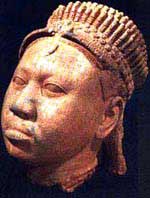 |
 |
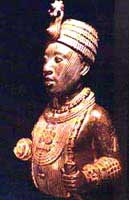 |
| 6 - Ife Museum. Terracotta | 7 - Lagos,
National museum. Terracotta |
8 - Ife museum. Bronze |
Ricerca Ing. F.P. Di Giacomo - Dati e cartografia in internet: Alpha Consult S.r.l - Web: G. Cerica |
|||